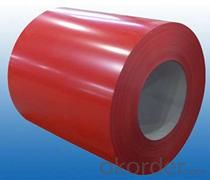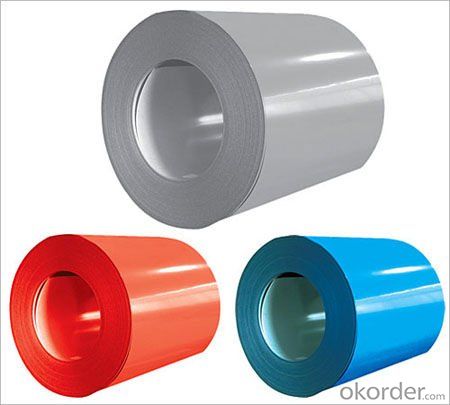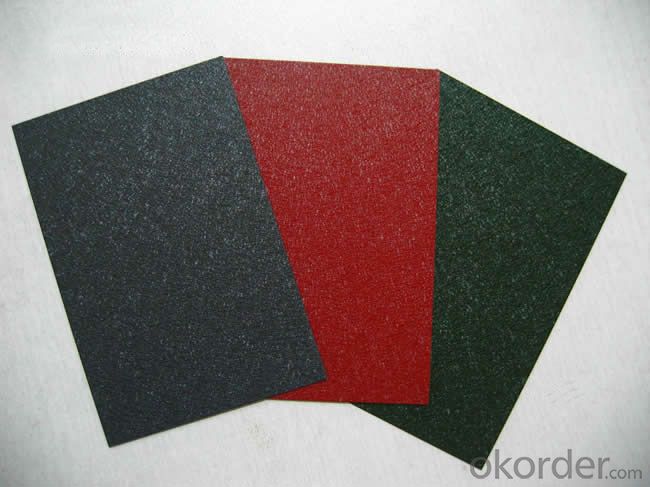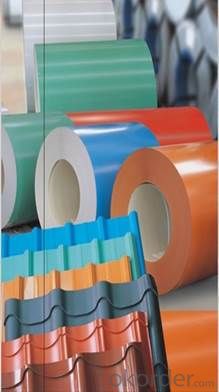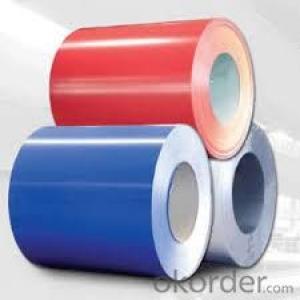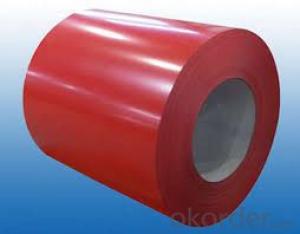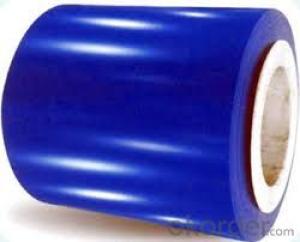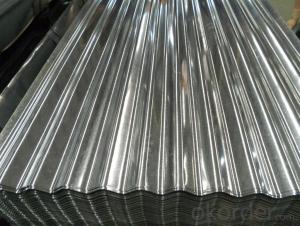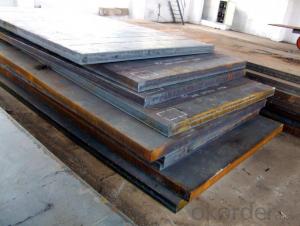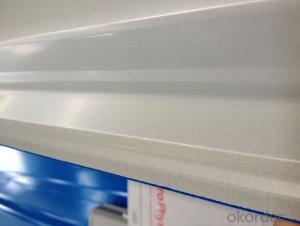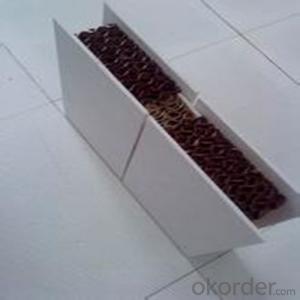Prepainted galvanized steel sheets/coils SGCC
- Loading Port:
- Tianjin
- Payment Terms:
- TT OR LC
- Min Order Qty:
- 25 m.t.
- Supply Capability:
- 200000 m.t./month
OKorder Service Pledge
OKorder Financial Service
You Might Also Like
1) AVAILABLE DESIGNATION OF (Prepainted galvanized steel coils) printed PPGI coils
Quality Q/BQB 440-2003 JIS G3312-1994 EN 10326-2004 ASTM A653-02a
EN 10327-2004 (BASE PLATE)
(BASE PLATE)
Commercial Steel TDC51D CGCC DX51D+Z/AZ CS Type A/B/C
Forming Steel (TSt01,TSt02,TSt03) CGCD1 FS Type A, Type B
Drawing TDC52D /TDC53D - DX52D+Z/AZ DDS TYPE A/C
Steel DX53D+Z/AZ
Structural TS280GD(TStE28) CGC400 S280D+Z/AZ SS275
Steel TS350GD(TStE34) CGC440 S350D+Z/AZ SS340 Class1
2) OUR SPECIFICATION OF (Prepainted galvanized steel coils) printed PPGI coils
Available Size:
Manufacturer Thickness Width Length of plate Inner diameter of coil
JIANGSU HUIYE STEEL SHEET CO.,LTD 0.2-1.2mm 800/914/1000/1200/1219/1250mm 1000-6000mm 508mm/610mm
Coated Mass OF (Prepainted galvanized steel coils) printed PPGI coils:
Base plate Available Coated Mass(g/m^2)
Galvanized Steel 80, 100, 120, 160, 180
Galvalume Steel 50, 70, 150
Available Painting OF (Prepainted galvanized steel coils) printed PPGI coils:
Category of Painting Item Code
Polyester PE
High-durability polyester HDP
Silicon modified polyesters SMP
Polyvinylidene fluoride PVDF
Easy-Cleaning —
Painting Thickness Top side: 20+5microns;
Bottom side: 5~7microns.
Color System Produce according to RAL Color System or as per buyer’s color sample.
Painting structure Top surface Bottom surface
Primer coating No coating 1/0
Primer coating Primer coating 1/1
Primer coating + Finish coating No coating 2/0
Primer coating + Finish coating Primer coating or single back coating 2/1
Primer coating + Finish coating Primer coating + Finish back coating 2/2
- Q: What are the insulation properties of steel sheets?
- Compared to other commonly used insulation materials like fiberglass or foam, steel sheets have relatively poor insulation properties. This is because steel is an excellent conductor of heat and electricity, possessing high thermal conductivity. Consequently, steel sheets are ineffective in preventing heat transfer and are not typically used as standalone insulation materials. Nonetheless, steel sheets can still offer some insulation benefits when utilized alongside other insulating materials. For example, they can serve as a protective layer or cladding, enhancing the durability and fire resistance of insulation systems. Additionally, they can function as a radiant barrier, redirecting heat away from buildings and reducing heat gain in warm climates. To summarize, although steel sheets themselves do not possess exceptional insulation properties, they can contribute to improving overall insulation performance when combined with other insulating materials or applied in specific scenarios such as radiant barriers.
- Q: Can steel sheets be used for interior wall applications?
- Yes, steel sheets can be used for interior wall applications. Steel sheets are strong, durable, and fire-resistant, making them suitable for use in various indoor settings. They can be installed as decorative panels or as a base material for wall cladding systems. Additionally, steel sheets offer benefits such as easy maintenance, excellent sound insulation, and the ability to withstand moisture and humidity.
- Q: Steel plate coated cement mortar, how can bonding firm?
- We've done this kind of projectIt can be used to weld some broken wire mesh or suitable waste steel bar on the steel plate, which can play the effect of scraping, and then plastering according to the general procedure. The effect is fine, there are basically no hollowing
- Q: Are steel sheets suitable for automotive applications?
- Yes, steel sheets are suitable for automotive applications. They are commonly used in the automotive industry due to their high strength, durability, and formability. Steel sheets provide excellent crash resistance, structural integrity, and can be easily molded into various shapes and sizes required for automotive components. Additionally, steel sheets offer good corrosion resistance and can be cost-effective compared to other materials, making them a reliable choice for automotive applications.
- Q: What is the average lifespan of a steel sheet roof?
- The average lifespan of a steel sheet roof can vary depending on various factors such as the quality of the steel, installation techniques, climate conditions, and maintenance. However, a well-maintained steel sheet roof can typically last between 30 to 50 years or even longer.
- Q: What is the difference between a painted and powder coated steel sheet?
- The application process and resulting finish distinguish painted steel sheets from powder coated steel sheets. Painted steel sheets are typically covered with a liquid paint, which can be applied through various methods such as spraying, brushing, or dipping. This liquid paint contains pigments and binders that stick to the steel surface and create a protective layer. It is possible to customize the paint in terms of color, gloss, and texture, allowing for a multitude of design options. However, painted surfaces may be susceptible to chipping, peeling, and fading over time, especially in harsh environments or with exposure to UV radiation. On the other hand, powder coated steel sheets are coated with a dry powder, which is electrostatically administered to the steel surface. The powder consists of a blend of finely ground particles, including pigments, resins, and additives. When applied, the steel sheet is heated, causing the powder particles to melt and fuse together, resulting in a sturdy and consistent coating. The outcome is a smooth, uniform finish that offers exceptional resistance to chipping, scratching, and UV radiation. Powder coating also provides a wider range of color choices and finishes compared to traditional liquid paint. In conclusion, although both painted and powder coated steel sheets offer protection and aesthetic appeal, powder coating provides superior durability, damage resistance, and a broader range of design possibilities.
- Q: What are the different alloying elements used in steel sheets?
- There are several alloying elements used in steel sheets to enhance their properties and performance. Some of the commonly used alloying elements include: 1. Carbon: The most important alloying element in steel, carbon provides strength and hardness to the material. It also improves the steel's ability to be heat-treated, making it suitable for various applications. 2. Manganese: Manganese is commonly added to steel sheets to improve their mechanical properties, such as strength and toughness. It also helps in reducing the brittleness of the steel. 3. Chromium: Chromium is added to steel sheets to enhance their corrosion resistance. It forms a thin protective layer on the surface of the steel, preventing it from rusting or corroding easily. 4. Nickel: Nickel is often used in steel sheets to improve their toughness and resistance to impact. It also enhances the steel's ability to withstand extreme temperatures, making it suitable for high-temperature applications. 5. Silicon: Silicon is commonly added to steel sheets to improve their strength and hardness. It also helps in deoxidizing the steel during the manufacturing process. 6. Vanadium: Vanadium is used as an alloying element in steel sheets to improve their strength, toughness, and heat resistance. It also helps in refining the grain structure of the steel, making it more uniform and fine. 7. Copper: Copper is added to steel sheets to improve their corrosion resistance and thermal conductivity. It also enhances the steel's ability to be welded and brazed. 8. Tungsten: Tungsten is used as an alloying element in steel sheets to improve their hardness, strength, and wear resistance. It is often added in small amounts to enhance the steel's cutting and drilling capabilities. These are just a few examples of the alloying elements commonly used in steel sheets. The choice of alloying elements depends on the specific requirements of the application and the desired properties of the steel. Different combinations and concentrations of these elements can be used to achieve a wide range of characteristics in steel sheets.
- Q: Can the steel sheets be used for automotive body panels?
- Yes, steel sheets can be used for automotive body panels due to their strength, durability, and ability to withstand impact and corrosion.
- Q: How do you prevent scratches or dents on steel sheets?
- One way to prevent scratches or dents on steel sheets is by using protective coatings or films. These coatings act as a barrier and help minimize damage caused by handling or transportation. Additionally, using proper handling equipment and techniques, such as using padded clamps or avoiding dragging the sheets, can also help prevent scratches or dents.
- Q: What is the difference between a coated and uncoated stainless steel sheet?
- A coated stainless steel sheet is one that has undergone a protective layer or finish application, which can be a polymer or another material. This coating enhances the sheet's ability to resist corrosion, scratches, and other types of damage. Moreover, the coating offers decorative appeal by presenting various colors or textures. In contrast, an uncoated stainless steel sheet refers to a sheet without any additional protective layer or finish. It retains its natural state, with its inherent properties and characteristics. Uncoated stainless steel sheets are renowned for their exceptional resistance to corrosion, durability, and strength. They are commonly employed in situations where their natural properties are sufficient to withstand the intended environment. The primary distinction between coated and uncoated stainless steel sheets lies in their protective capabilities and appearance. Coated sheets provide an extra layer of protection against corrosion and damage, making them suitable for environments exposed to harsh conditions or corrosive substances. Additionally, they offer a wider range of design options due to the various coatings available. On the other hand, uncoated stainless steel sheets are preferred in applications where the inherent properties of stainless steel are adequate to meet the requirements. They are often utilized in architectural and structural projects, as well as in industries such as food processing, pharmaceuticals, and medical equipment, where hygiene and durability are crucial. To summarize, the difference between coated and uncoated stainless steel sheets lies in the additional protective layer and aesthetic options offered by the coating. Coated sheets provide enhanced resistance to corrosion and damage, along with a broader range of design choices. Uncoated sheets rely on their inherent properties for durability and strength. The selection between the two hinges on the specific application and the desired balance between protection, aesthetics, and cost.
Send your message to us
Prepainted galvanized steel sheets/coils SGCC
- Loading Port:
- Tianjin
- Payment Terms:
- TT OR LC
- Min Order Qty:
- 25 m.t.
- Supply Capability:
- 200000 m.t./month
OKorder Service Pledge
OKorder Financial Service
Similar products
Hot products
Hot Searches
Related keywords





